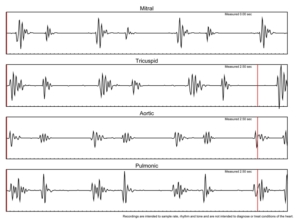
Your heart is a miraculous organ. Every day your heart beats 100,000 times, sending 2,000 gallons of blood surging through your body. It emits a field of electromagnetic energy at a higher level than the brain. It is resilient and made to beat strong forever. Yet, in the USA and a majority of Western European countries hearts are being weakened.
According to the CDC, heart disease is still the leading cause of death for both men and women in the United States. About 610,000 people die of heart disease in the United States every year– that’s one in every four deaths. Every year about 735,000 Americans have a heart attack, of these, 525,000 are a first heart attack and 210,000 happen in people who have already had a heart attack.
For more information you can visit the CDC’s website for more facts and information on heart disease. https://www.cdc.gov/heartdisease/facts.htm.
Here in our clinic we have what’s called a heart sound recorder, it is a computer-based, low risk general wellness monitor which uses the principles of auscultation to observe heart sounds. The heart’s reaction to certain stressors, (i.e. chemical, nutritional, and emotional), can be observed using this type of device. Certain types of heart stress can be monitored by seeing the rate, rhythm, and tone of the heart cycle on the graph.
(Principles of auscultation means the source of every sound is a vibrating body which produces a series of waves in surrounding medium i.e. air. Usually waves are vibrating at the same rate as that of the vibrating body and reach the ears causing vibrations of the eardrums and middle ear producing the sensation of sound). In other words, this device listens to heart sounds, like a stethoscope, as a health care provider would be doing during an examination.
Below is an example of a near perfect graph from a heart sound recorder reading in the Mitral valve. The Tricuspid valve has a split sound and some disturbance in the rest period. The Aortic Valve has a diminished first sound and a larger second sound. The Pulmonic valve has a higher second sound.

These findings are indicators of nutritional deficiencies. It is interesting to ponder that the heart speaks to us in many ways and that one of the ways is to tell us the nutritional deficiencies of the body. At this point it would be wise and prudent to state that the HSR (heart sound recorder) uses heart sounds to find nutritional deficiencies of the body and when these deficiencies are satisfied the heart beats anew. Royal Lee had a different opinion.
“…We can say that we find no condition, either directly or indirectly, so responsive to nutritional therapy as that which is reflected in heart conditions.”
-Dr. Royal Lee
You can also visit our website for this information on our heart sound recorder at http://sourcehealthcenter.com/patients/heart-sound-recorder/.






